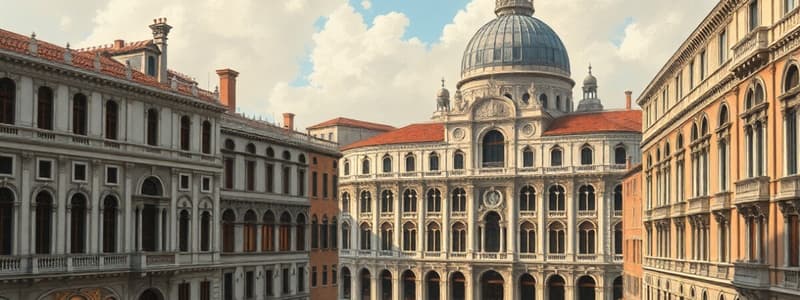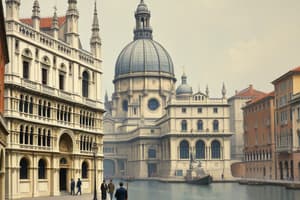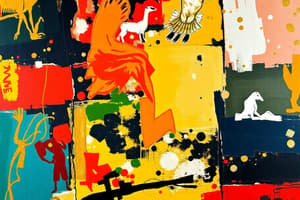Podcast
Questions and Answers
What primary geographical feature significantly aided Venice in repelling King Pippin's attack in 810?
What primary geographical feature significantly aided Venice in repelling King Pippin's attack in 810?
- The surrounding mountain ranges.
- The strong city walls of Venice.
- The geographic of the Venetian lagoon. (correct)
- The extensive canal system within the city.
The establishment of the Arsenal in 1104 only had a political impact on Venice by strengthening its military capabilities.
The establishment of the Arsenal in 1104 only had a political impact on Venice by strengthening its military capabilities.
False (B)
What title did Doge Pietro II Orseolo earn in 1000 after defeating the Narentine pirates and taking control of Dalmatian towns?
What title did Doge Pietro II Orseolo earn in 1000 after defeating the Narentine pirates and taking control of Dalmatian towns?
Dux Dalmaticorum
In 1297, Venice's government structure became more ______ when membership in the Maggior Consiglio was restricted to aristocratic families.
In 1297, Venice's government structure became more ______ when membership in the Maggior Consiglio was restricted to aristocratic families.
Match the following Venetian governing bodies with their primary function:
Match the following Venetian governing bodies with their primary function:
What was the main purpose of Venice establishing its Maritime Codes in 1255?
What was the main purpose of Venice establishing its Maritime Codes in 1255?
The conflict between Venice and Ferrara from 1308 to 1313 was primarily about religious differences, leading the Pope to place an interdict on Venice.
The conflict between Venice and Ferrara from 1308 to 1313 was primarily about religious differences, leading the Pope to place an interdict on Venice.
What strategic benefit did Venice gain by acquiring Treviso in 1339?
What strategic benefit did Venice gain by acquiring Treviso in 1339?
The introduction of the ______ in 1284 became a symbol of Venetian economic power and remained a key currency for centuries.
The introduction of the ______ in 1284 became a symbol of Venetian economic power and remained a key currency for centuries.
Match each event with its lasting impact on the Venetian government:
Match each event with its lasting impact on the Venetian government:
What was the primary reason for the conflicts between Venice and Genoa from the 13th to 14th centuries?
What was the primary reason for the conflicts between Venice and Genoa from the 13th to 14th centuries?
The Congress of Venice in 1177 resulted in a complete victory for the Holy Roman Emperor Frederick I over the Pope.
The Congress of Venice in 1177 resulted in a complete victory for the Holy Roman Emperor Frederick I over the Pope.
What action did Venice take in 1329 to generate revenue and reduce state costs related to its naval fleet?
What action did Venice take in 1329 to generate revenue and reduce state costs related to its naval fleet?
Between 1145 and 1153, Venice expanded its control over the Istrian Peninsula, becoming known as ______.
Between 1145 and 1153, Venice expanded its control over the Istrian Peninsula, becoming known as ______.
Match the following events with their impact on Venice's territorial expansion:
Match the following events with their impact on Venice's territorial expansion:
How did the attack on Comacchio in 866 influence Venice's economic development?
How did the attack on Comacchio in 866 influence Venice's economic development?
The establishment of the Quaranta in 1220 increased the Doge's power by giving him more control over judicial matters.
The establishment of the Quaranta in 1220 increased the Doge's power by giving him more control over judicial matters.
Who led Venice during the Fourth Crusade, playing a key role in the sack of Constantinople?
Who led Venice during the Fourth Crusade, playing a key role in the sack of Constantinople?
In 1355, Doge Marino Faliero was ______ for attempting to overthrow the Venetian government.
In 1355, Doge Marino Faliero was ______ for attempting to overthrow the Venetian government.
Match the following councils and bodies with their descriptions:
Match the following councils and bodies with their descriptions:
What direct impact did Venice's control of the Po River region in 1240 have on its economy?
What direct impact did Venice's control of the Po River region in 1240 have on its economy?
The Polo family's voyages to the Far East primarily resulted in territorial gains for Venice in China and Central Asia.
The Polo family's voyages to the Far East primarily resulted in territorial gains for Venice in China and Central Asia.
What was the main consequence of Venice's victory in the War of Chioggia (Fourth War with Genoa)?
What was the main consequence of Venice's victory in the War of Chioggia (Fourth War with Genoa)?
In 697, Venice was able to establish its independence from the ______ Empire.
In 697, Venice was able to establish its independence from the ______ Empire.
What was the main reason Venice launched attacks on the coast of Durazzo in 1081?
What was the main reason Venice launched attacks on the coast of Durazzo in 1081?
Flashcards
Who was the first Doge?
Who was the first Doge?
Elected in 697, he helped Venice establish independence from the Byzantine Empire.
Who was King Pippin?
Who was King Pippin?
In 810, this Frankish king's attack was unsuccessful due to Venice's lagoon geography and diseases.
What is Dux Dalmaticorum?
What is Dux Dalmaticorum?
In 1000, this title was earned by Doge Pietro II Orseolo after defeating Narentine pirates and controlling Dalmatian towns.
What was the Arsenal?
What was the Arsenal?
Signup and view all the flashcards
What was the Consilium Sapiential?
What was the Consilium Sapiential?
Signup and view all the flashcards
What was the Congress of Venice?
What was the Congress of Venice?
Signup and view all the flashcards
What was “a quarter and a half?”
What was “a quarter and a half?”
Signup and view all the flashcards
What was the Quaranta?
What was the Quaranta?
Signup and view all the flashcards
What was the Senate (Pregadi)?
What was the Senate (Pregadi)?
Signup and view all the flashcards
What are the Maritime Codes?
What are the Maritime Codes?
Signup and view all the flashcards
What was the gold ducat?
What was the gold ducat?
Signup and view all the flashcards
What was the Maggior Consiglio?
What was the Maggior Consiglio?
Signup and view all the flashcards
What was the Council of Ten?
What was the Council of Ten?
Signup and view all the flashcards
Who was Doge Marino Faliero?
Who was Doge Marino Faliero?
Signup and view all the flashcards
What was the War of Chioggia?
What was the War of Chioggia?
Signup and view all the flashcards
Study Notes
- The following are key events in the rise of the Venetian government, along with details regarding their relevance.
Early Independence and Expansion
- 697: Paolucci Angaseto was elected as the first Doge, enabling Venice to establish independence from the Byzantine Empire.
- 810: King Pippin, son of Charlemagne, launched a Frankish attack on Venice to bring it under Carolingian control; Venice's lagoon geography and diseases forced Pippin to retreat, assisting in Venice's independence and positioning as a strong maritime power.
- 866: Arabs attacked and sacked Comacchio, a trading center near Venice; this weakened Venice's trade rival, allowing Venice to grow stronger in the region.
- 1000: Doge Pietro II Orseolo defeated Narentine pirates and took control of Dalmatian towns, earning the title Dux Dalmaticorum, strengthening Venice’s power, securing trade routes, and marking its expansion in the Adriatic Sea.
Limiting Doge Power
- 1032: Two wealthy merchants from each side of the Great Canal were elected to serve as advisors to the Doge and impose restrictions on Doge power.
- 1143: Venice established the Consilium Sapiential, a council of senior advisors to the Doge, forming the city's political system and ensuring more stable governance.
- 1178: Venice formed the Council of Six Advisors to assist the Doge, limiting his power and involving more nobles in governance.
- 1220: Venice established the Quaranta, a council of forty judges, which handled civil and criminal cases, limited the Doge’s power, and became the foundation for future Venetian courts.
- 1255: The Pregadi, also known as the Senate, was formally established to manage foreign affairs, trade policies, and financial matters; it included 120 members chosen from the nobility, marking a step toward a more structured government and limiting the Doge's authority.
Trade and Military
- 1081: Venice launched attacks on the coast of Durazzo to defeat Normans, to protect trade routes.
- 1104: Venice established the Arsenal, a large shipyard, strengthening its military by enabling quick ship production, increasing the city's influence and creating jobs, enhancing trade, and contributing to Venice's wealth.
- 1122-1124: Doge Domenico Michele supported the Crusades, aiding Crusaders and strengthening ties with the Byzantine Empire and gaining privileges for Venetian merchants and trade.
- 1145-1153: Venice expanded its control over the Istrian Peninsula, becoming "Totius Istria Dominator,” securing key territories, strengthening its influence in the Adriatic, and consolidating its power.
- 1240: Venice gained control over the Po River region, an important waterway in northern Italy, strengthening trade routes for goods moving between northern Italy and the Adriatic, expanding Venice’s influence over nearby territories, and allowing access to secure vital supply lines while maintaining dominance over rival cities.
- 1255: Venice implemented its Maritime Codes, regulating trade, shipping, and sea conduct to protect merchants and strengthen Venice's power as a maritime empire.
- 1257: Venice erected the Pillars of Acre, symbolizing its dominance in the Crusader States, and signed its first treaty with Genoa to manage trade rivalries and tensions.
- 1261-1295: The Polo family, including Marco Polo, expanded Venetian influence in the Far East, establishing key trade routes with China and Central Asia, and significantly enhancing Venice's wealth and power.
- 1268: Venice established the Quarantana, a council of 40 members responsible for overseeing public finances and taxation, helping maintain the city's economic stability.
- 1284: Venice introduced the gold ducat, a coin that became a symbol of Venetian economic power, widely used in trade and remaining a key currency for centuries.
- 1329: Venice began auctioning its galleys to generate revenue and reduce state costs, allowing private merchants to use the ships for trade or military purposes.
- 1386: Venice occupied Corfu, securing control of the island to strengthen its position in the Ionian Sea and protect its trade routes.
Conflicts and Consolidation
- 1177: The Congress of Venice ended the conflict between the Pope and Emperor Frederick I, with Venice mediating a peace that recognized the Pope’s authority and Venice’s independence.
- 1201-1204: Venice, led by Doge Enrico Dandolo, played a key role in the Fourth Crusade by transporting crusaders to Constantinople, which they sacked in 1204, gaining “a quarter and a half” of the Byzantine Empire, including key trade ports, boosting its power in the Eastern Mediterranean.
- 1294-1299: Venice and Genoa fought their Second War over control of Mediterranean trade routes and influence, ending in a stalemate that marked a continued struggle for control over trade and naval supremacy.
- 1308-1313: Venice fought Ferrara for control of the Po River region, during which the Pope placed an interdict on Venice, suspending religious services, due to the city's opposition to the Papacy; the war ended with some Venetian territorial gains.
- 1310: The Tiepolo Conspiracy, an attempt to overthrow the Venetian government, was thwarted, leading to the creation of the Council of Ten to strengthen internal security and prevent future uprisings.
- 1339: Venice acquired Treviso, strengthening its control over the Venetian mainland and political power in northern Italy.
- 1350-1355: Venice fought the Third War with Genoa over control of Mediterranean trade routes, ending in a stalemate, but maintaining their positions.
- 1355: Doge Marino Faliero was executed for attempting to overthrow the Venetian government after being convicted of treason.
- 1358: Venice gained control of Dalmatia through the Treaty of Zadar after defeating Hungary, expanding its influence in Adriatic.
- 1378-1381: Venice won the War of Chioggia (Fourth War with Genoa), defeating Genoa and securing Venetian dominance in the Mediterranean.
- 1389-1420: Venice expanded control over the Veneto mainland, capturing cities like Verona and Vicenza.
- 1409-1420: Venice regained control of Dalmatia, expanding its power in the Adriatic.
- 1424-1430: Venice attempted to control Thessalonica, but it was captured by the Ottomans in 1430.
- 1425-1454: Venice was involved in a series of wars in Lombardy against various regional powers, including Milan, expanding its territory and influence in northern Italy and securing key cities and trade routes.
Social and Political Changes
- 1297: Venice restricted membership in the Maggior Consiglio to aristocratic families, reinforcing an oligarchic government and consolidating power within the Venetian elite.
- 1347-1348: The plague struck Venice, causing widespread death and social disruption, impacting its economy and trade, but Venice gradually recovered.
- 1423: Francesco Foscari was elected Doge of Venice, which lasted until 1457.
Studying That Suits You
Use AI to generate personalized quizzes and flashcards to suit your learning preferences.




